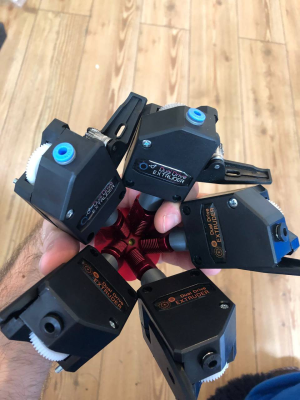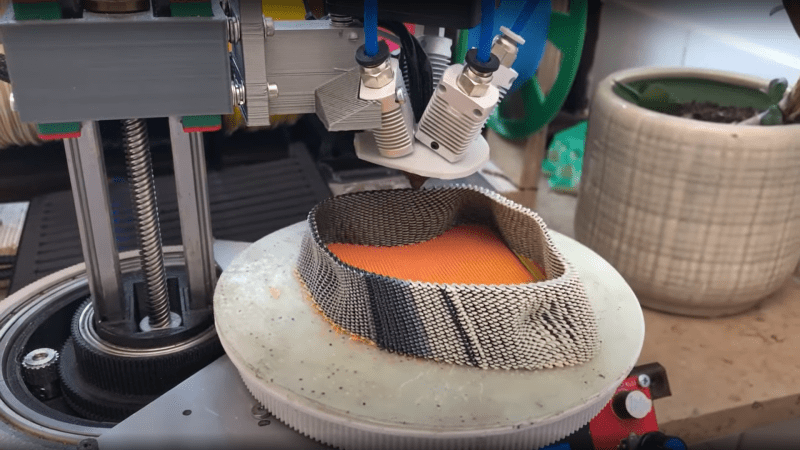We’ve seen this funky dual disk polar printer already recently, but [Heinz Loepmeier] has been busy working on it, so here’s an update. The primary focus here is nozzleboss, a blender plugin which enables the surface textures of already sliced objects to be manipulated. The idea is to read in the gcode for the object, and convert it to an internal mesh representation that blender needs in order to function. From there the desired textures can be applied to the surfaces for subsequent stages to operate upon. One trick that nozzleboss can do is to create weight maps to tweak the extrusion flow rate or print velocity value according to the pixel value at the surface — such ‘velocity painting’ can produce some very subtle surface effects on previously featureless faces. Another trick is to use the same weight maps and simply map colours to blender text blocks which are injected into the gcode at export time. These gcode blocks can be used swap tool heads or extruders, enabling blending of multiple filament colours or types in the same object.
trick is to use the same weight maps and simply map colours to blender text blocks which are injected into the gcode at export time. These gcode blocks can be used swap tool heads or extruders, enabling blending of multiple filament colours or types in the same object.
Some nice examples of such printing manipulation can be seen on [Heinz’s] instagram page for the project. So, going back to the hardware again, the first video embedded below shows the ‘dual disk polar printer’ fitted with a crazy five-extruders-into-one-nozzle mixing hotend setup, which should be capable of full CMYK colour mixing and some. The second video below shows an interesting by-product of the wide horizontal motion range of the machine, that the whole printing area can be shifted to a nozzle at the other end of the gantry. This enables a novel way to switch extruders, by just moving the whole bed and print under the nozzle of interest! One final observation — is that of the print surface — it does look rather like they’re printing direct onto a slab of marble, which I think is the first time we’ve seen that.
Interesting printer designs are being worked on a lot these days, here’s a really nice 5-axis prusa i3 hack, and if you want to stay in the cartesian world, but your desktop machine is just too small, then you can always supersize it.
















Neat. Still a lot of activity in this area. I let my son do the printing. I just send him the stl files :) and somehow out pops a part.
My son sent a picture of a 3D printed castle that is just a little bigger than a human hair. Looks like we can print at almost any scale now…..
I tried something similar.
There was a chess game here on HAD that used core-xy or Hbot but it was rotated 45 degrees because otherwise the kinematic drive wouldn’t fit.
Cartesian systems really have a large kinematic drive to print area ratio that is only slightly better if you are printing something square.
If you change the order of the sequential sacra kinematics then you end up with something that uses big rotational bearings and has a large printable area. Big rotational bearings are far far cheaper than linear rails and linear bearings. This is a huge cost saving.
You just have to deal with more complex kinematics that wont fit on an 8-bitter. Perhaps do the conversion on a pc/laptop that has pulse this motor wait Xus, pulse that motor wait Yus.
My project was a little more complex as it was inverted arc delta parallel kinematics so I have to start again and start with the math.
The big advantage to the xy style machines is they fit in a neat square footprint, and its pretty much immediately clear how large a footprint – which makes them much easier to fit a big working area into your work space than the rotational systems (as almost all existing furniture etc will be square edged you end up needing heaps of wasted space around a rotating system for clearance), also helps that their precision is entirely consistent across the whole mechanism – that one step always equals the same movement relative to the work and its easier to build the heated chamber for those finicky filaments.
That said I do agree there are some great reasons to use scara and delta style kinematics, I’d just not call either an obvious choice for most places as humans tend to deal in boxes over cylinder and cones (said as somebody who’s only currently working printer is a delta – will be rebuilding the really neat little xy box when the v2 smoothieboards finally ship).
Slab of marble? From the project logs, it looks like it’s drilled fiberglass sheet.
Well, there is an image of a piece of drilled fibreglass, but the images from the video really don’t match it so well. It looks like it has a really glossy surface and there is a distinct colouration at the edge, which looks exactly what you’d get with cut and polished marble.